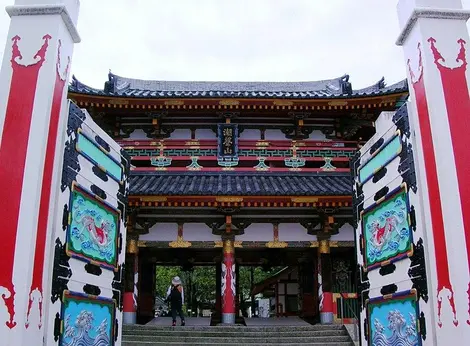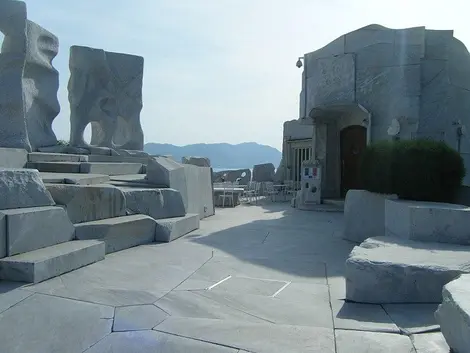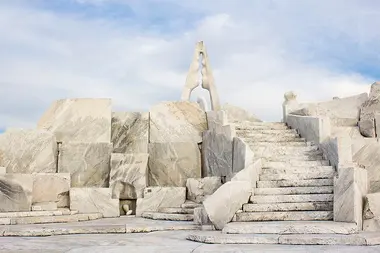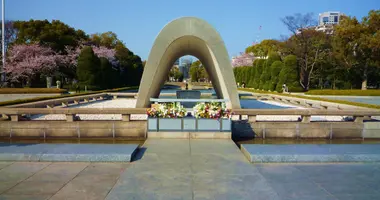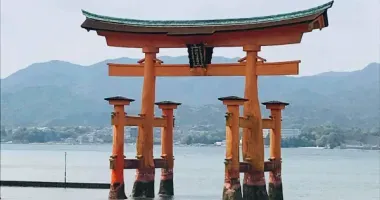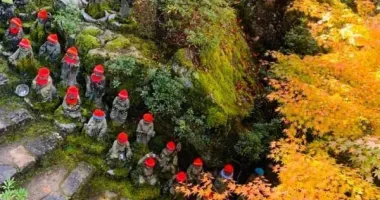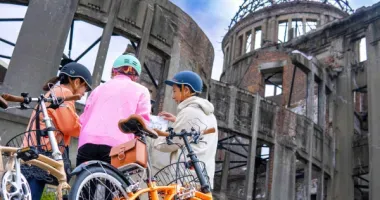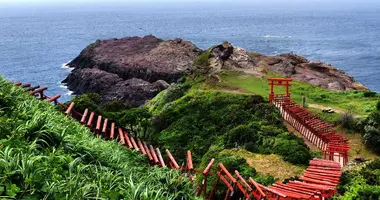Kosan-ji Temple 耕三寺
- Published on : 20/05/2019
- by : S.V.
- Youtube
The love of a son
When they want to give their mother a gift, some children give flowers, write a poem or compose a song. The businessman, Kanemoto Kosanji, opted for an unconventional present; a gift worthy of the gratitude he wanted to show his mother but also of his means!
Unlimited devotion
The Kosanji is a huge complex of the Jodo Shinshu Honganji sect, the Pure Land school of Buddhism located on the island of Ikuchijima, about 18 km from Onomichi in Hiroshima prefecture.
Spread over four levels , the Kosanji covers a vast area of 55,000 m². This set is the work of a wealthy businessman, Kanemoto Kosanji (1891-1970) . Following the death of his mother in 1934, the industrialist who then ran a steel tube manufacturing company in Osaka made a decision; that of building a temple in honor of his deceased mother . It is close to her heart to offer her this ultimate gift as a sign of gratitude for the love she has shown him and the dedication she has shown throughout her life.
Far from being satisfied with a single building, the man will have a set of twenty buildings built . A titanic work that will last 30 years!
In 1927, he had already had a very fine residence built for her: the Choseikaku villa , today within the grounds of the Kosanji. This is a subtle blend of Japanese architecture and Western architecture, featuring all the latest technological innovations of the time in terms of comfort.
Kanemoto Kosanji himself took care of the quality of the materials used and the decoration down to the smallest detail, calling on renowned artists for the paintings of the sliding doors and the many works of art present in the house.
A well inspired man
A year after the disappearance of his mother, the Kosan-ji radically changes his life. The businessman becomes a Buddhist monk and takes the name Koso Kosanji .
For several decades, he devoted all his energy to building the Kosanji, which was inspired by his mother's favorite temples , including buildings listed as National Treasures.
No wonder then if during your visit certain elements remind you of other famous places in the archipelago such as the Imperial Palace in Kyoto , the Shitenno-ji in Osaka , the Hôryû-ji in Nara ... Here , any resemblance to existing buildings is purely coincidental!
Kosanji drew inspiration from buildings of different styles and eras ranging from the Asuka period (538-719) to the Edo period (1603-1868) .
In the upper level, the Koyomon gate is inspired by the Yomeimon gate of the Nikko Tôshôgû shrine dating from 1636 and classified as a national treasure since 1902. Located behind the five-storey pagoda of Kosanji, the Koyomon is particularly luxurious and sparkling. This door alone required ten years of work. The hondo or main hall is a replica of the Phoenix pavilion of the gleaming Byôdô-in in Uji .
The "Kosanji Style"
Nevertheless, it is important to clear up a misunderstanding. Koso Kosanji did not just make simple copies of gates, pagodas, halls or sculptures. The inspiration is certainly present but the monk wanted to bring his personal touch by sometimes giving free rein to his imagination and by making modifications .
Some sculptures are much larger, the buildings much more colorful and the gilding more sparkling. Some buildings are even original constructions like the Rakan-dô on the lower level. The Kosanji is far from being an amusement park where it would be practical to admire in one and the same place some of the greatest architectural treasures of the archipelago.
We have as proof of this the classification of 15 of the buildings as Important Cultural Assets at the national level ; full recognition of the "Kosanji style".
A museum and a marble garden
Koso Kosanji was also a great collector of classical Japanese art . Rich in more than 2,000 works and objects of art, 19 of which are classified as Cultural Assets of the country, its collection has been exhibited since 1955 in the Kosanji Museum which takes place in three pavilions of the temple.
At the very last level of Kosanji, one last surprise awaits the visitor: the Miraishin no Oka or Hill of Hope . Perched at the top of the hill, this garden entirely in Carrara marble was sculpted by Ittô Kuetani . This environmental sculptor, originally from Kozan in Hiroshima prefecture, worked between 1988 and 2000 on this monumental work; i.e. 16 years of labor to create a veritable immaculate white garden out of the blocks of stone.
The slightest element, the slightest shape of the garden, the sculpted monuments like "The Tower of Hope" or the "Celestial Cat" harmonize perfectly with the surrounding nature . A sublime contemporary creation worthy of this emblematic place of filial love.
Address, timetable & access
Address
Phone
0845-27-0800Timetable
By boat: From Onomichi, 40 minutes by boat to Setoda Port or 25 minutes from Mihara Port By car: Nishiseto Expressway (Shimanami Kaido), 10 minutes from Ikuchijima-Kita Highway Interchange Exit ( coming from Honshu) or 10 min from the exit of the Ikuchijima-Minami highway interchange (coming from Shikoku)Price
Adult: 1,400 yen. Student: 1,000 yen. High school student: 800 yen. Child: freeAccess
Open daily from 9 a.m. to 5 p.m. Villa Choseikaku is open from 10 a.m. to 4 p.m.Website
http://www.kousanji.or.jp/french/




